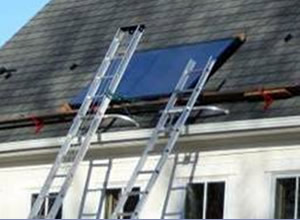- 1 read

Miscellaneous Upgrades to Your Home Get Aid from the American Recovery and Reinvestment Act of 2009. Source: GREENandSAVE.com
On February 17, 2009, President Barack Obama signed the American Recovery and Reinvestment Act (ARRA) of 2009. All told, the bill calls for the spending of $787 billion dollars over the next number of years on the expansion of unemployment benefits and other social welfare programs, and domestic spending on health care, education, and infrastructure, which includes the entire energy sector.
The bill sets aside $5 billion for the weatherizing of modest-income homes, but you have to know how to get that money. A lot of that money will be distributed as Tax Credits on the installation of new, more energy-efficient products that will help wean the United States off of its dependence on fossil fuels. Listed below are the details on Home Improvement.
The ARRA allots $4.3 billion for improving the energy efficiency of homes in 2009 and 2010. Homeowners can recoup up to 30% of the cost of one specific project up to $1,500, which also includes installation costs for heating and cooling equipment. The ARRA triples the amount available for a tax credit from $500 to $1,500. It also removes the cap on geothermal heat pumps and solar energy through 2016.
To be eligible the tax credit for improving energy-efficiency of a home, you have to be purchasing and installing products at very specific standards. There are two standards for which home improvements can qualify for the tax credit. The first is for items placed in service (installed and running) between January 1, 2009 and February 17, 2009. The terms of the tax credit are less clear for this time period, however the Internal Revenue Service will likely clarify these terms in guidance documents, which are expected to be released later this year.
The second standard, which is documented below, applies to products placed in service between February 18, 2009 and December 31, 2010. Listed below are the specifics for miscellaneous improvements to your home or lifestyle, like solar panels, alternative fuels and hybrid vehicles, and while they share similarities, each product demands different levels of efficiency.
Small Wind Energy Systems
For this to qualify for a tax credit, it must have been placed in service before December 31, 2016, and is not limited to any cap. You may receive the full 30% tax credit for this product.
Fuel Cells
For a fuel cell to qualify for a tax credit, it must have an efficiency of at least 30% and a capacity of at least .5 kWh. It has to have been placed in service by December 31, 2016, and is not limited to the previous cap of $1,500.
Solar Energy Systems – Like geothermal heat pumps, solar energy systems have no capped amount for a tax rebate. The tax credit is worth the full 30% of your total costs plus installation. You will need to use IRS form 5695. This will only qualify for solar panel installations that occur before December 31, 2016.
Solar Water Heating
To qualify, at least half of the energy generated by the “qualifying property” must come from the sun. Also, homeowners may only claim spending on the solar water heating system property, and not the entire water heating system for the household. The credit will not be extended for the heating of swimming pools or hot tubs, as the water must be used in the dwelling. Lastly, the system must be certified by the Solar Rating and Certification Corporation (SRCC). This tax credit used to have a $2,000 cap, but that has been done away with. This credit may also be claimed against the alternative minimum tax.
Photovoltaic Systems
Photovoltaic systems must provide electricity for the residence, and must meet all applicable fire and electrical code requirements.
The ARRA repealed some penalties that formerly were associated with Solar Technology. The ARRA repeals the penalty for subsidized renewable energy financing. This allows businesses and individuals to qualify for the full amount of the credit, even if projects receive subsidized energy financing (i.e. below market loans, tax preferred bonds, state grants, etc.). This amendment applies to the period after December 31, 2008.
Cars
Hybrid Gasoline-Electric, Diesel, Battery-Electric, Alternative Fuel, and Fuel Cell Vehicles
The tax credit for a vehicle listed above will be based on a formula determined by vehicle weight, technology, and fuel economy compared to base year models, but will not exceed $7,500. There is a 60,000 vehicle limit per manufacturer, after which a phase out period begins. Toyota and Honda have already had their tax credits phased out, however the credits still exist for Ford, General Motors, and Nissan. For more information on this topic, see FuelEconomy.gov.
For hybrid vehicles purchased for personal use, use IRS form 8910. For hybrid vehicles purchased for business purposes, use IRS form 3800.
Plug-in Hybrid-Electric Vehicles
The tax credit for these vehicles is between $2,500 and $7,500. The first 250,000 vehicles sold will be eligible for the tax credit, at which point the credit is phased out as in the case with the non-plug-in hybrids. This is effective January 1, 2009.
GREENandSAVE.com is a free resource for anyone that wants to save energy, money, and the environment. The articles, product reviews, online tools, and return on investment calculations are researched from a diverse range of public and private sector sources. Overall, the company is passionate about saving money as well as creating healthy homes, offices, and lifestyles.
For ways to improve your home without Government Assistance, take a look at GREENandSAVE.com for your next Green Home Remodeling project. Or, for more information on one major project that can save you money on utility bills, take a look at the GREENandSAVE article on Solar Hot Water Heaters.

